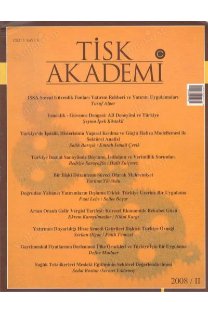Cinsiyete bağlı insani gelişme endeks yaklaşımları: Türkiye örneği
Ulusal İnsani Gelişme Raporları, Türkiye'de yoksullukla savaşımın çok aktörlü ve geniş katılımlı bir ortaklık anlayışı ile yürütülmesini özendirme vizyonunu taşımaktadır. Birleşmiş Milletler’in 2008 yılı Küresel İnsani Gelişme Raporu “İklim Değişikliğiyle Mücadele: Bölünmüş Bir Dünya’da İnsani Dayanışma” odaklıdır. 2007/2008 İnsani Gelişme Raporu uzun zamandır uluslararası gündemde yar alan iklim değişikliği sorununun hak ettiği en büyük ilgiyi görmeye başladığı dönemde sunulmuştur. Hükümetler arası iklim değişikliği panelinin son bulguları adeta savaş borusu çalmakta, gezegenimize ait iklim sisteminin ısındığını kesin bir biçimde onaylamakta ve nedenini doğrudan insan davranı şlarına bağlamaktadır. Bu çalışmada, İstatistiki Bölge Birimleri Sınışaması, Düzey 2’ye göre Cinsiyete Bağlı İnsani Gelişme Endeksi (CBİGE) farklı alternatif yaklaşımlara göre hesaplanmıştır. Türkiye ve Dünya ölçeğine göre, endeksi oluşturan bileşenlerin aritmetik ve geometrik ortalamalarına göre endeks değeri hesaplanmıştır. Endeks değerlerine göre; genel olarak Avrupa Birliği İstatistiki Bölge Birimleri Sınışaması (İBBS)’ye göre Düzey 1 seviyesinde Kuzeydoğu Anadolu, Ortadoğu Anadolu ve Güneydoğu Anadolu bölgelerindeki, Düzey 2 seviyesinde alt bölgelerin tamamına yakın kısmının, göreceli olarak Batı Marmara, Ege ve Doğu Marmara bölgelerindeki alt bölgelere göre hayli düşüktür. 2005 ve 2008 yılları için CBİGE değerleri endeks sıra numaralarına göre “sıra numara analizi” ile test edilmiş ve farklılıklar istatistiksel olarak ortaya konulmuştur. 2008 yılında genel olarak tüm alt bölgelerde endekse eğitim bileşeni, en yüksek katkıyı sağlamıştır. 2005 ve 2008 yılları arasında genel olarak alt bölgelerin CBİGE değerlerinde bir yükselme eğilimi gözlenmesine karşın bu eğilim, alt bölgelerin yüksek kategoride yer alabilmeleri için yeterli olmamıştır. Aynı yıllar için alt bölgelerin CBİGE değerlerine göre sıralamasayıları arasındaki farkın 0,05 yanılma düzeyinde istatistiksel olarak önemli olduğu sonucuna varılmıştır.
Gender approaches for induced human development indeces for Turkey
National Human Development Reports, the struggle against poverty in Turkey, and broad participation of multiple actors with the execution of a partnership approach is encouraged to carry the vision. In 2008 the United Nations Global Human Development Report "Fighting Climate Change: Human Solidarity in a World Divided" oriented. 2007/2008 Human Development Report is a long time the international agenda on climate change in the split of the greatest interest in the problem began to see merit in the period are presented. Intergovernmental panel on climate change findings nearly the end of the pipe is playing the war, our planet is warming of the climate system is approved in precisely the reason is directly connected to human behavior. In this study, Statistical Classification of Territorial Units, Level 2, Human Development Index according to gender Associate (CBIGE) was calculated according to the different alternative approaches. Turkey and the world according to the scale, the components of the index, according to the arithmetic and geometric mean index value was calculated. According to the index value, in general, the European Union Statistical Area Classification Units (NUTS) according to Level 1 at the level of North East Anatolia, the Middle East Anatolia and Southeast Anatolia regions in the, Level 2 at the level of the entire sub-region close to the part, relatively Western Marmara, Aegean and Marmara regions in East According to the sub-region is very low. For the years 2005 and 2008, according to the sequence number in the index CBIGE value "analysis of the sequence number" and has been tested and has been shown to be statistically different. In 2008, as a general education component of the index of all the sub-region, has provided the highest contribution. Between the years 2005 and 2008, mainly in sub-regions for an upward movement of CBIGE although this trend to be observed, sub-regions can be included in the high category was not enough. For years, sub-regions of the same sort of CBIGE value of the difference between the numbers of error at the level of 0.05 were concluded to be statistically significant.
___
- Akder, A.H. (1994). A Means to Closing Caps: Disaggregated Human Development Index, Occasional Paper 18. New York: Human Development Report Office. Demir, S. (2006). Birleşmiş Milletler Kalkı nma Programı, İnsani Gelişme Endeksi ve Türkiye Açısından Değerlendirme. DPT. Ankara.
- ESRI, (1991). Map Projection and Coordinate Management–Arc-Info User’s Guide. Environmental Systems Research Institute Inc. (A43)-(A44)p.
- Hoşgör, Ş. (1997). Estimating of Post Childhood Life Tables of Provinces And Regions In Turkey by Using Age and Sex Distributions and Intercensal Growth Rates, 1985-1990. Phd Dissertation, Institute of Population Studies, Hacettepe University. Ankara.
- Kutlu, M. (2002). UNDP İnsani Gelişme Raporu Skandalı www.eylem.com/hdr/hdr2002.htm Erişim tarihi 16.06.2010.
- TURKSTAT, (2000). 2000 Census of Po Pulation Social and Economic Characteristics of Population. Ankara.
- UNDP, (1998). Human Development Report, 1998. New York: Oxford University Press.
- UN, (2000). Handbook on Geographic Information Systems and Digital Mapping Annex II – Coordinate Systems and Map Projections, 133-144p.UNDP, 2000. Human Development Report, 2000. New York: Oxford University Press.
- UNDP, (2004). Human Development Report, Turkey, 2004. New York: Oxford University Press.
- UNDP, (2006). Human Development Report, 2006. New York: Oxford University Press.
- UNDP, (2003). New Poverty and the Changing Welfare Regime of Turkey.
- UNDP, (2008). Human Development Report, Turkey, 2008. New York: Oxford University Press.
- UNDP, 2008. Human Development Report, 2007/08. New York: Oxford University Press.
- Uygur, S., Yıldırım, F. (2007). Cinsiyete Bağlı İnsani Gelişme Endeksi, 2005. 16. İstatistik Araştırma Sempozyumu. Ankara.
- www.tuik.gov.tr Erişim tarihi 01.01.2010 www.undp.org/en/reports/global/hdr2007 2008 Erişim tarihi 21.03.2010.
- www.undp.org/tur/reports/national/hdr2007-2008 Erişim tarihi 26.03.2010.
- ISSN: 1306-6757
- Yayın Aralığı: Yılda 2 Sayı
- Başlangıç: 2006
- Yayıncı: Türkiye Isveren Sendikalari Konfederasyonu
Sayıdaki Diğer Makaleler
İşyerinde şiddet davranışlarının çalışanlar üzerindeki etkisi: Bir uygulama
SALİH DURSUN, SEVİNÇ SERPİL AYTAÇ
Finansal serbestleşme ve firma finansmanı
Ekrem KARAYILMAZLAR, DOĞAN BAKIRTAŞ
İş sözleşmesinin geçerli sebeple feshinde ultima ratio ve sosyal seçim ilkeleri
Cinsiyete bağlı insani gelişme endeks yaklaşımları: Türkiye örneği
Türk imalat sanayiinde geri ve ileri bağlantılar: Girdi-çıktı tablosuna dayalı yapısal bir çözümleme
